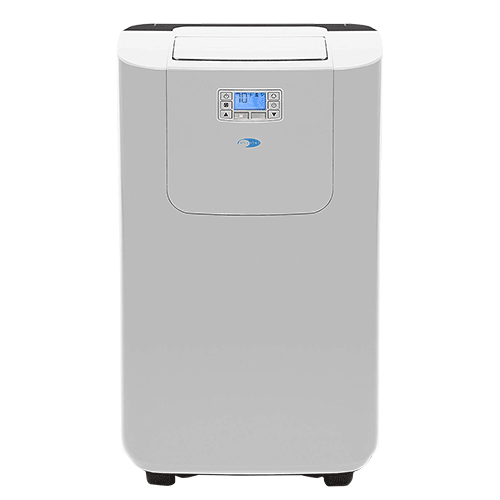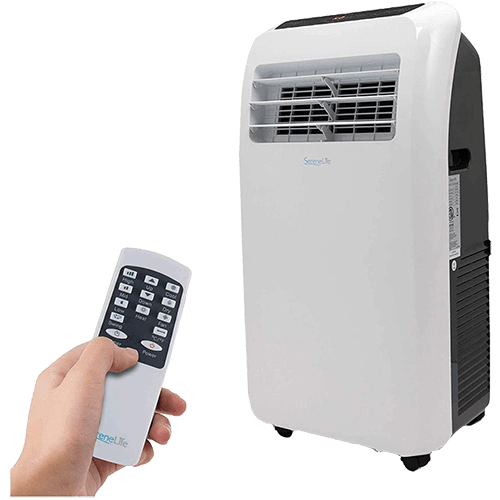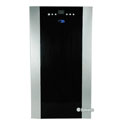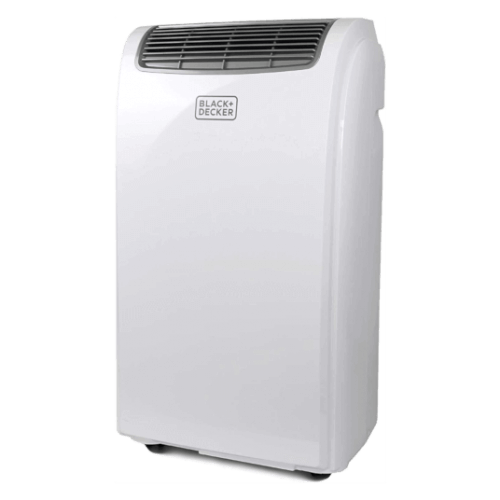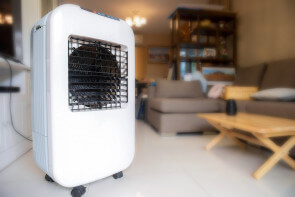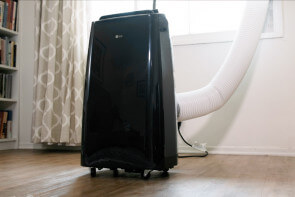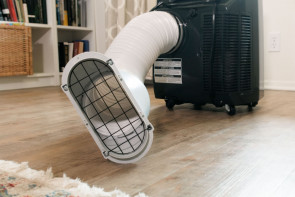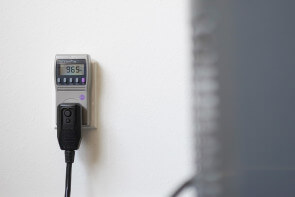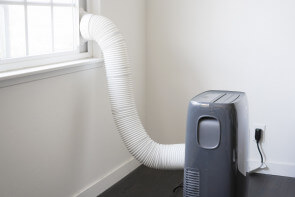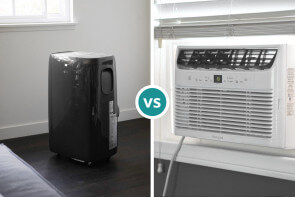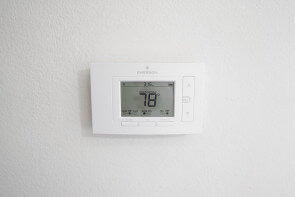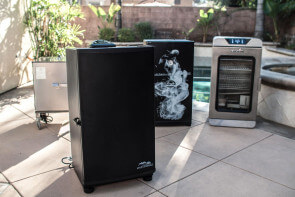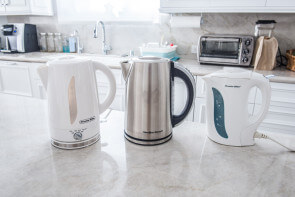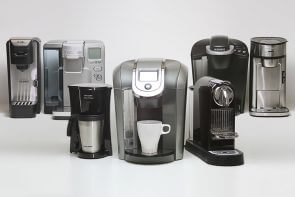
The Best Portable Air Conditioners
After five summers of testing in the California heat, our tests show that the best portable air conditioner overall is the dual-hose Whynter – ARC-122DS Elite. The best window air conditioner is always going to cool more effectively than a portable, but the Whynter will at least minimize the amount of cold air that’s wasted. This 12,000 BTU Whynter is also fairly quiet compared to the company’s big 14,000 BTU model that we also tested. For this 2021 update, we tested a new single-hose portable air conditioner, SereneLife 12,000 BTU, and were equally impressed by its cooling performance.
After five summers of testing in the California heat, our tests show that the best portable air conditioner overall is the dual-hose Whynter – ARC-122DS Elite. The best window air conditioner is always going to cool more effectively than a portable, but the Whynter will at least minimize the amount of cold air that’s wasted. This 12,000 BTU Whynter is also fairly quiet compared to the company’s big 14,000 BTU model that we also tested. For this 2021 update, we tested a new single-hose portable air conditioner, SereneLife 12,000 BTU, and were equally impressed by its cooling performance.
Table of contents
- The 11 portable air conditioners we tested
- Best for heat waves: Whynter – 12,000 BTU
- Best single-hose: SereneLife 12,000 BTU
- For extreme heat: Whynter – 14,000 BTU
- Budget pick: Black + Decker – 8,000 BTU
- How we selected
- How we tested
- Important features to consider
- Single vs. dual hose units
- How many BTUs do you need?
- The bottom line
The 11 portable air conditioners we tested

| Product | Cost | BTU Class | Max Noise (dBA) | Weight (lb) |
|---|---|---|---|---|
| 1. Whynter - ARC-122DS Elite | $$$ | 12,000 | 66 | 60 |
| 2. SereneLife - SLACHT128 | $$$ | 12,000 | 68 | 71 |
| 3. Whynter - ARC-14SH | $$$$ | 14,000 | 75 | 100 |
| 4. Black + Decker - BPACT08WT | $$ | 8,000 | 63 | 53 |
| 5. Koldfront - PAC802W | $$ | 8,000 | 65 | 57 |
| 6. LG - LP1218GXR | (Discontinued) | 12,000 | 67 | 64 |
| 7. LG - LP1220GSR | (Discontinued) | 12,000 | 67 | 62 |
| 8. LG - LP1215GXR | (Discontinued) | 12,000 | 66 | 62 |
| 9. Frigidaire - FFPA1222U1 | (Discontinued) | 12,000 | 67 | 65 |
| 10. LG - LP1217GXR | (Discontinued) | 12,000 | 68 | 67 |
| 11. Honeywell - MN10CESWW | (Discontinued) | 10,000 | 68 | 68 |
Best for heat waves: Whynter – 12,000 BTU
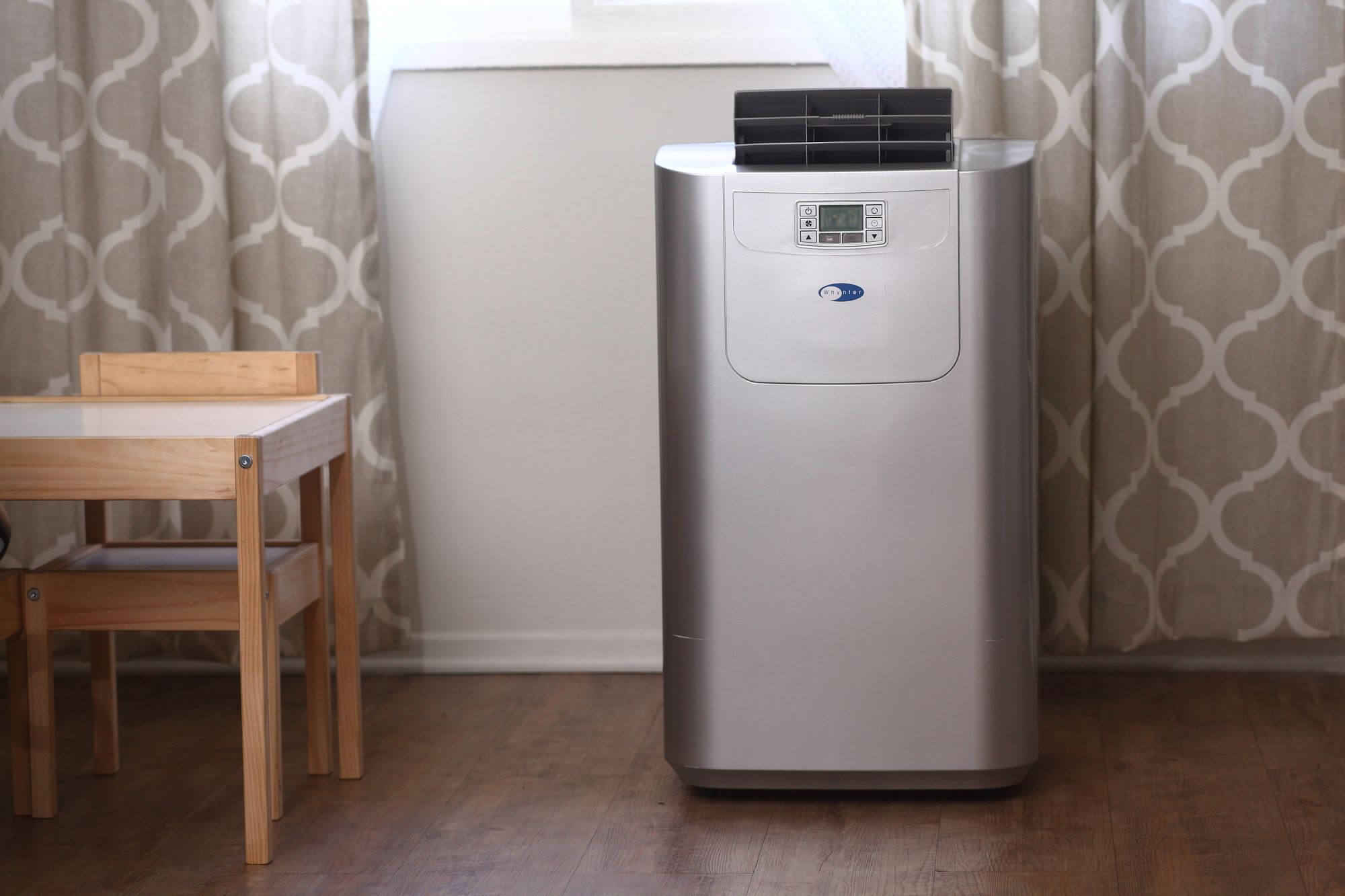
The ARC-122 DS Elite from Whynter is a quiet dual-hose air conditioner, and that makes it a bit of a unicorn. Dual-hose models are rare enough as it is!
When we initially ran tests in 80–90°F heat, we didn’t see much benefit from bulkier dual-hose setups. But if you’re buying a portable air conditioner because you expect temperatures to climb above 95°F, a dual-hose system can still do its job, while a single-hose model will heat up your room. We’ve confirmed the engineering principles behind this with our own test in a real heatwave, and we think the bulk of a second hose is a worthwhile compromise in most cases.
We looked at other tests of dual-hose portables and didn’t see any other models with noise or performance specs that were competitive.
In more moderate conditions the Whynter’s performance lead isn’t as strong over good single-hose designs, but at least it’s still one of the quietest.
Best for Heat Waves: Whynter - 12,000 BTU
Whynter practically owns the market for dual-hose AC, so if you're anticipating scorching hot temperatures, this is the way to go. This is a quiet air conditioner that will be able to handle heat waves better than any single-hose design. If you're not expecting to see temperatures above 95°F, though, there are better options
While Whynter is neck and neck for noise output with the LG in this size class, the screen is hard to see without crouching down, and if you’re using the remote control you still have to walk over and open or close the vent manually. There’s a slipcover included for storage, which is nice, but the paint and overall look are disappointing.
Finally, when comparing peak power draw of portables we tested, the Whynter was about 70 watts higher than the competition. Not a huge gap, given other performance factors, but notable.
Key takeaways:
- The Whynter – ARC-122DS Elite will beat any single-hose design during a heatwave, and that’s usually the time when performance is most important.
- Despite the best-in-class design, this portable air conditioner still can’t compete with a smaller window unit.
- Whynter is one of the few manufacturers focusing on dual-hose designs, so there’s not a lot of competition.
- Noise output from this model is competitive with the best single-hose models.
- The design is a bit clunky-looking, but its lighter weight makes it relatively portable.
Best single-hose: SereneLife – SLACHT128

For this 2021 update, we tested the 12,000 BTU SereneLife – SLACHT128 and were impressed by how quickly it cooled down our 250 square-foot office on a 96°F summer day. This unit also has a built-in humidifier and 7,000 BTU heating power. It’s relatively slim and lightweight for its BTU class and can easily be rolled from room to room.
Remember, though, that wherever you place the SereneLife, it needs to be close to a window for the venting hose. This model comes with an easy-install window kit that works best with windows that open/close up and down. Our test site had windows that open left to right, and the window kit was tricky to install.
Once plugged in, the SereneLife automatically shows the current temperature of the room: a nice feature that’s not usually built-in. Its cooling mode is set as the default when you power up. Desired temperature, speed, and duration can be programmed manually or with the excellent remote that can be controlled from the far end of the room. We tested the strength of cooling power from 8 feet away, and though it was not as forceful as when we stood 3 feet away, it was still a pleasant, cool breeze.
Another feature we liked is the unit’s “swing” mode, which, when activated, shifts the vents up and down automatically, allowing for more coverage of the airflow. Unless you’re sweltering, you wouldn’t want to sit too close to the air conditioner. We had set the air conditioner’s temperature to 72°F, and the breeze registered at 3 feet away as a very chilly 50°F. So the SereneLife is ideal for a bedroom where you would place it in a corner — and not in front of the bed — to cool the entire room.
If you’re wondering about how loud the SereneLife is, even when the compressor kicked in, it registered at 68 decibels, which is normal for an air conditioner. But most of the time, it hovered between 62 and 65 decibels and shouldn’t disturb your sleep.
Whether you’re using the cooling function or the dehumidifier, water is collected in the unit’s reservoir that needs to be emptied. It’s easy with the SereneLife. A drainage tube is included and you just put one end in a bucket and the other in the reservoir outlet, and the water drains out in a few seconds.
Despite the extreme-temperature days during which we tested the SereneLife, we did brave testing the heating function and found it to be competent but not extraordinary. You’ll still probably need a portable heater.
The SereneLife is about 30 bucks less than the Wynter, and if you’re looking for a single-hose portable air conditioner, it’s a great product to consider purchasing.
Key takeaways:
- The SereneLife – SLACHT128 is a slim, lightweight model that’s easily portable and can cool rooms up to 450 square feet.
- Its powerful breeze, even on low, can cool a room on a hot summer day in minutes.
- This 10,000 BTU model also has a dehumidifier and a 7,000 BTU heating function.
For extreme conditions: Whynter – 14,000 BTU

If you’re looking for a big portable air conditioner that doesn’t need to move or sit in your bedroom, the Whynter – ARC-14SH may be a better choice, especially if your climate skews on the much hotter side.
A dual-hose design like the ARC-122 Elite already has a leg up on our single-hose picks in terms of system design, but the biggest member of Whynter’s team also has a compressor and coil system that can soak up more heat.
The DOE still down-rates capacity to 8,500 BTUs in average real-world conditions, but as outside temperatures increase, the difference between this and a single-hose unit will be more and more noticeable.
One unique feature this particular Whynter model has is a “heat pump” heating mode that works fairly well above 45°F. This feature of the Whynter may be a good fit for your home or office. That said, the options in our space heater review will still work if you ever need to deal with freezing temperatures.
We liked the versatility and power of the Whynter when we tested it in our older office building. The open floor plan gets both too hot and too cold depending on the season, so the versatility came in handy, but it’s so loud we very nearly had to draw straws to decide who would sit next to it.
Key takeaways:
- The Whynter – ARC-14SH will provide the most cooling in a larger space during the hottest months.
- That extra cooling power means far more noise.
- This particular model also comes with a heating mode that works above 45°F.
Budget pick: Black + Decker – 8,000 BTU

If you need a quick solution for cooling down a bedroom or office, you can’t install a window unit, and you can’t afford the full price of the top picks in this review, a small 8,000 BTU portable air conditioner like the Black + Decker – BPACT08WT for around $300 can still help you stay cool.
Let’s not mince words here: An 8,000 BTU single-hose portable will only cool a very small room, and it will start to heat up that small room just as quickly when outdoor temperatures climb into triple digits.
If your outdoor air isn’t hotter than 95°F, you may not mind the slow warming of the rest of your house while you sit in the dry, cool airstream coming off the evaporator coil. Still, many people dealing with those conditions will do just as well with a tower fan.
Compared to other budget-priced portable air conditioners, the Black+Decker is surprisingly quiet. With only a 1 dB(A) spike in noise when the compressor kicks on or off, it’s about the same level of noise as our two top-ranked 12,000 BTU picks, though those models move more air and soak up far more heat.
The 8,000 BTU Black+Decker is, as expected, smaller than a 12,000 BTU design, but it’s still heavy and awkward to move. Calling any air conditioner “portable” is a stretch, but this is on the lighter end of what’s available.
There’s a cable spool in the back for keeping things neater in storage, but finding a place to keep the hose and bracket is still the biggest inconvenience. There’s no storage compartment for the remote, either.
Key takeaways:
- The Black + Decker – BPACT08WT can cool a small room on moderate days, and it’s quieter than other models.
- On extra-hot days a small portable air conditioner is worse than just using a fan.
- The best window air conditioner is about the same price and can cool a room far better.
Koldfront – 8,000 BTU
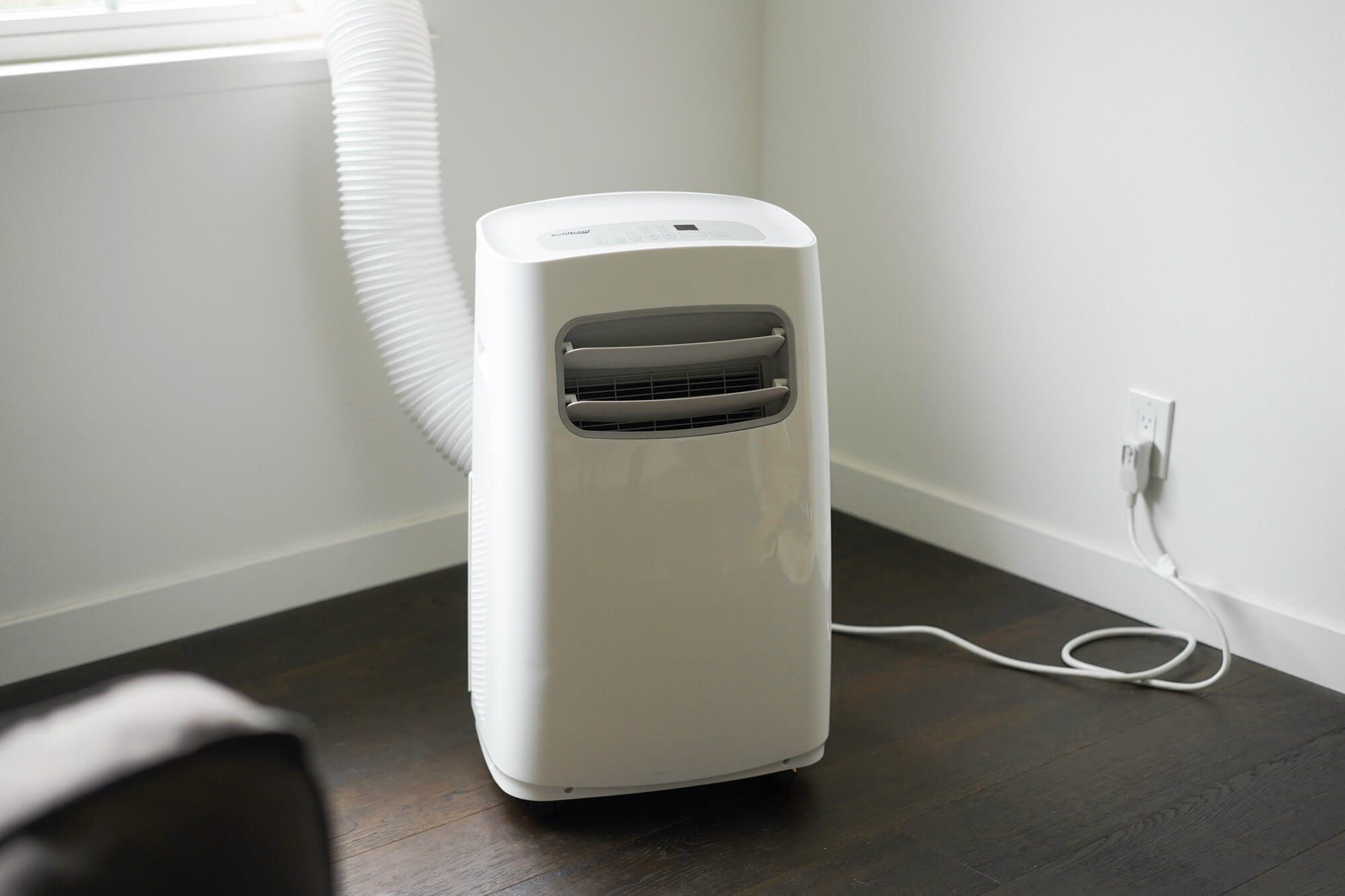
The Koldfront – PAC802W is one of many small portable air conditioners that have become popular because of their low price, and it probably comes out of the same factory as the Midea – MPF08CR81-E and Danby – DPA100B6WDB.
The Koldfront is one of the most affordable portable air conditioners on the market, selling for considerably less than big-name models. The corner-cutting shows through when you use it on a daily basis, though: the compressor is quite loud when starting and stopping. It’s not as loud as the giant Whynter – 14000 BTU we tested, but it also can’t offer nearly as much cooling capacity.
LG – 12,000 BTU (Discontinued)

(Editor’s note: The two LG – 12,000 BTU models that we tested LP1218GXR and LP1220GSR have been discontinued. However, as of this 2021 update, Home Depot is still selling the 8,000 BTU LP1220GSR model.)
The LG – LP1218GXR is powerful, energy-efficient, relatively quiet, and not too pricey when compared with other single-hose designs. We’ve tested four versions of LG’s 12,000-BTU design, and this model is the best.
LG only makes single-hose designs, though. When a single-hose air conditioner blows air out your window to shed all the heat it collects in its condenser coil, it’s using air it just cooled, and it has to suck in air from the outside to replace it. If the weather is hotter than about 95°F outside, the incoming heat will overwhelm the air conditioner and your room will start to get hotter. (See our test results below.)
That said, for short periods of time or in milder conditions, a single-hose system can still remove enough heat to provide relief. The department of energy now rates portable air conditioner capacity with a “seasonal adjustment,” assuming 80% of the time you run an air conditioner it’s 83°F outside. With that adjustment to performance calculations, the LG single-hose design and Whynter dual-hose design are equally capable of removing 7,500 BTUs of heat. That’s down from a capacity of 12,000 BTUs possible in ideal laboratory conditions.
At the time of this writing, the best LG design is around $20 less expensive than the Frigidaire and $45 less than the Whynter. You could save more money by buying a smaller AC, but portables are enough of a performance compromise already that downsizing is risky.
If you’re dead-set on a single-hose design and you want something bigger, check out the 14,000-BTU LG – LP1419IVSM. The variable-speed inverter motor doesn’t need to stop and start every time the air reaches a high or low thermostat limit, so it’s quieter and more efficient at keeping a set temperature. This design makes the most sense if you’re using your air conditioner constantly on mildly hot days. The biggest problem is that it’s double the price of a 12,000 BTU option, and it will still struggle in 100-degree weather because of the single-hose design.
In 202, we tested LG’s latest model, the LP-1220GSR, and LG made a few changes to storage features we didn’t like, such as removing the cord management spool and magnetic remote control storage cubby. There’s a plastic cable tie and a wall-mount bracket instead; those would both be welcome additions to the old design, but the changes are a net loss.
Performance-wise, the 2020 model has 1.4 ounces less refrigerant inside, and it runs the fan and compressor a little bit faster to compensate. This means about 30 watts more power draw and 1 decibel more noise, so it’s a mild downgrade for most of the numbers we consider important.
The 2020 model is about 10 pounds lighter, though, and performance tests put it neck-and-neck with the old model — just a hair faster at the initial cooling of a room. If you can’t find the Whynter or the LP1218, the LP1220GSR is still a quiet and well-made portable air conditioner.
For our money, the sleek tapered design of the LG – LP1218GXR portable air conditioner is the best-looking. It also has features sorely missed on the Whynter, like a magnetized holder for the remote and a spindle to keep the cord wrapped when it’s in your closet. There’s even a nighttime mode that turns off the light!
Frigidaire – 12,000 BTU (Discontinued)
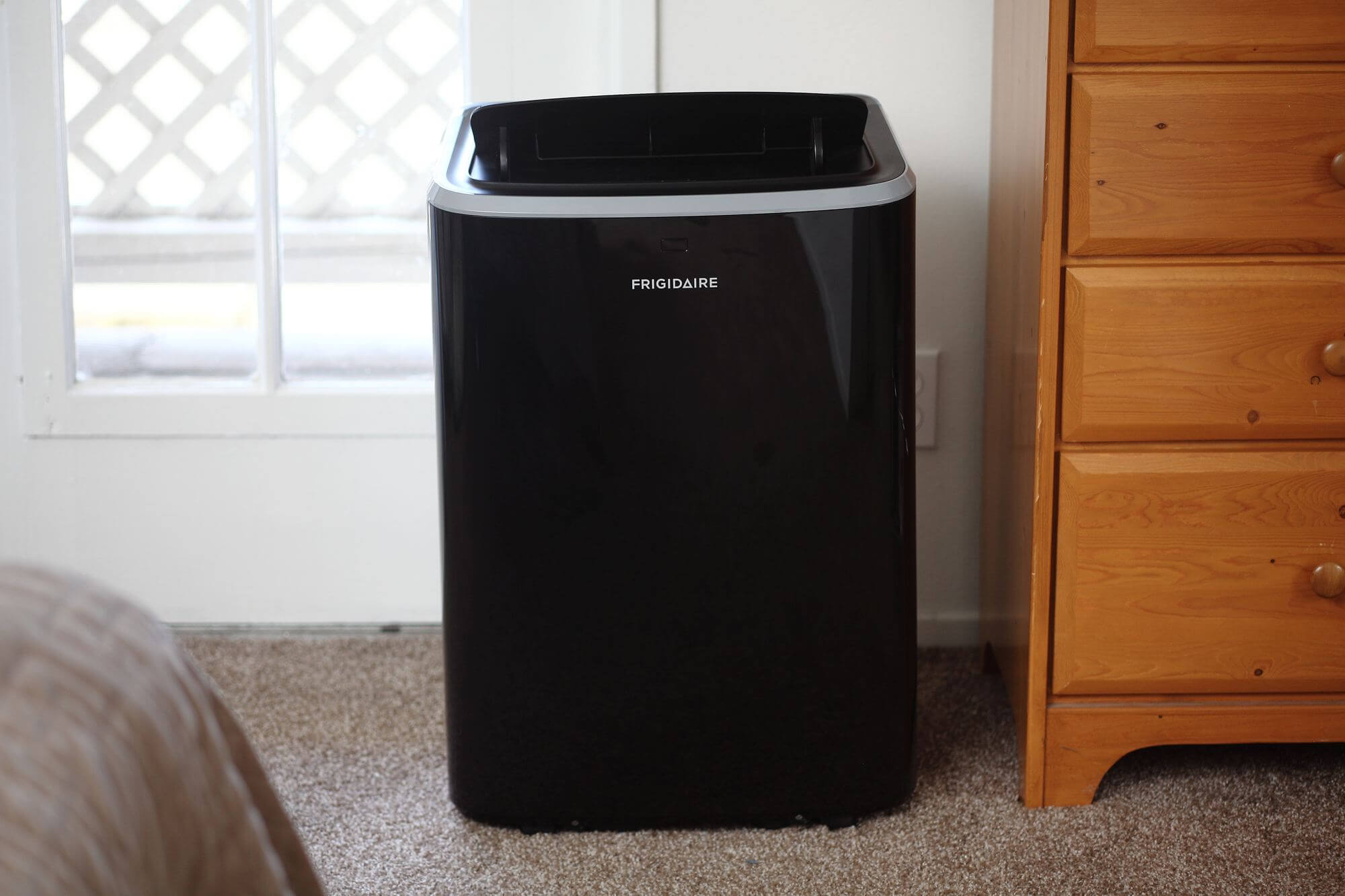
(Editor’s note: Frigidaire has discontinued manufacturing this 12,000 BTU model. However, three newer 13,000 BTU models are available at appliance stores. Check Frigidaire’s website for more information.)
Although the Frigidaire – FFPA1222U1 has a few strengths, its performance was not as strong as the LG, and it definitely can’t keep up with the Whynter dual-hose design on extra-hot days.
This portable has a nice feature that’s been deleted from LG’s newest models: a space on the back you can plug the cord into to keep it tidy in storage. There’s no remote control holder, though, and the sleep mode doesn’t dim the lights as much as we’d like.
The handles are set high on this model, which makes it a bit easier to pick up and move over a short distance (like when you’re clearing a threshold between rooms). It’s more top-heavy, though, so we still prefer LG’s design for rolling around or carrying longer distances.
The price for any of these models will bounce up and down as inventory shifts during summer heatwaves. Overall, the performance edge and lower noise of LG’s 2018 model make it a better choice even if it is $20-30 more.
Honeywell – 10,000 BTU (Discontinued)

(Editor’s note: Honeywell has discontinued its MN10CES model line. But a newer 10,000 BTU unit is available on Honeywell’s website.)
The Honeywell – MN10CESWW is an older unit, but it’s still a popular choice for many people — it has solid Amazon reviews, though the price has actually trended upward since we first reviewed it.
We’re obviously in the target buyer group: Two different households in our office owned the Honeywell for a combined total of four summers of use. While we were generally satisfied, “happy” would be pushing it.
Even compared to the bigger LG, this thing is hard to move, and we would often decide not to move it from room to room with us simply because of the inconvenience. Even in moderately hot environments, it really only functions as a cold fan.
This model is on the louder side, too, and frequently woke one tester in the middle of the night. Overall, it’s a solid product and one that got us by, but after testing the LG we better understand what you give up with a cheap portable air conditioner.
How we selected
When we first set out to test portable air conditioners, two of our team members had already owned the Honeywell 10,000 BTU portable AC unit, and we were all too familiar with the limitations of these machines.
We spent almost 40 hours looking for the best models on the market, reading all the tests results we could find from publications like Consumer Reports, Wirecutter, and Tech Gear Lab. We pored over consumer reviews on the web to find out what other people like and dislike about portable air conditioners.
We decided to focus on models made in-house by big manufacturers, trying to eliminate designs that would be identical inside their shells — this is pretty common among brands like Midea, Sunpentown, Keystone and Danby.

In 2018, we added the top-ranked 12,000 BTU dual-hose model from Whynter and the competitive Frigidaire single-hose, along with a surprise update from LG. We’ve seen one new 14,000 BTU-class machine hit the shelves since then, but nothing that competes for value or efficiency with our existing picks.
In 2020, we looked for more 14,000 BTU and 8,000 BTU models to test. The bigger designs we’ve looked at don’t have better performance specs, but we found some more affordable models that can replace our now-discontinued 10,000 BTU budget pick.
We briefly looked at the monstrous Wi-Fi-controlled Frigidaire Gallery model, but our experiences testing “smart” appliances for our garage door opener review and baby monitor review have made us skeptical. Using a $10 Wi-Fi-connected smart plug still makes more sense than paying hundreds more for a built-in controller on an undersized air conditioner.
How we tested
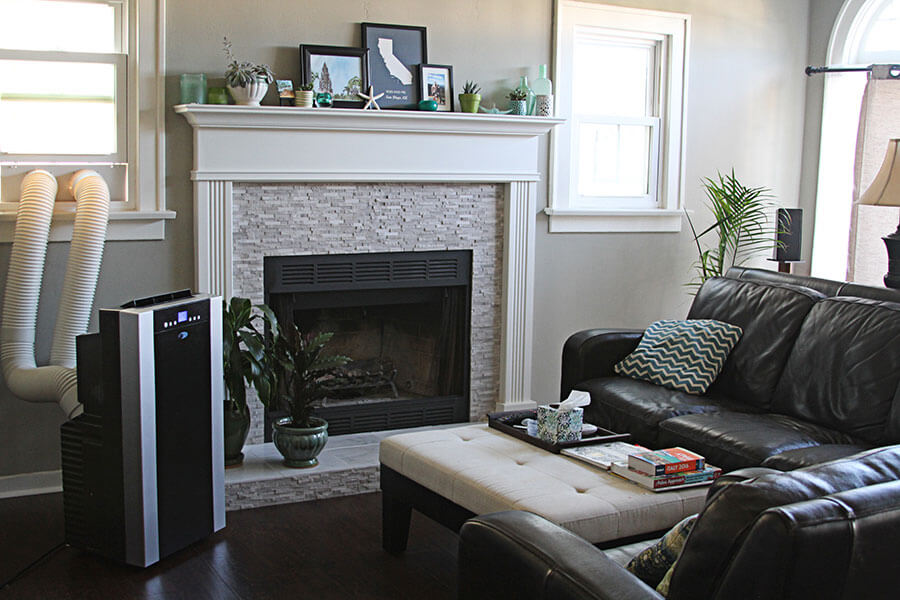
We’ve run tests over five summers, in conditions ranging from moderate 80-degree days to 105-degree heat waves. We’ve moved our portables between homes and offices, slept beside them, and run three different kinds of tests.
A portable AC unit needs to blow air through your window, and the included hose-and-baffle window kits are all equivalent in accomplishing that. They’re not pretty, but they do let you seal the window with the included foam tape. The LG uses gray plastic, while the other kits came in white.
We needed an extension for one room we tested in, so we cannibalized parts from the three LG window kits we had on hand. Extensions are only readily available from Honeywell, so buying a second window kit is probably your best bet if you don’t want to DIY something out of cardboard or Plexiglas.
Daily-use testing
For our first round of testing in 2016, we used a lineup of four portables in a San Diego home and measured the temperature change as they did their work over moderately hot days in two different room sizes.
In a 125-square-foot office in moderate 80-degree conditions, LG’s 12,000 BTU model was neck and neck with the powerhouse 14,000 Whynter dual-hose unit, and those two models actually left our tester feeling chilly — definitely better performance than we expected.
Once we moved the portables into a 450-square-foot great room, the 14,000 BTU size with its more efficient dual-hose system started to show its superiority over the others. But it was still disappointing for an air conditioner in a room that it’s nominally “rated for.”
Having used the 10,000 BTU Honeywell in the heat of summer, we can say that a smaller portable unit needs to be blowing directly on you. Even then, it’s not comfortable, it’s just barely getting you by.
Let’s not kid ourselves — portable air conditioners aren’t going to cool an entire house. In many ways, they’re best described as personal air conditioning units. If you think of them and use them that way, you’ll probably be happy with the cool breeze they make.
Controlled test setups
For further tests of updated models, we decided to focus on the “Goldilocks” size of 12,000 BTU models that worked best for most rooms in our first round of tests.
LG has been updating air conditioners on a fairly regular two-year cycle, with 2015, 2017, 2018 and 2020 releases. Since the 2015 model performed so well, we’ve tested all LG models as they’ve become available.
We also bought the Whynter and Frigidaire 12,000 BTU models in 2017, since their specs were competitive, and nobody else has tested these models against each other.
For our updated tests we tried three different methods for comparing these designs. First, in early summer when outside temperatures were only hitting 82°F, we heated our upstairs testing room from the inside to see what the actual peak performance of our machines was. Starting from a controlled 85°F and with 2,000 watts of ongoing heat (about 6,800 BTU) from a pair of space heaters, we ran the 12,000-BTU-rated portables for an hour.
Next, we shut off one heater to bring the load down to 800 watts for another hour, then turned off the last heater to see how the AC could cool in “easy” conditions.
We were a bit surprised at how poorly the Whynter dual-hose model was cooling the room in these tests. When we considered the reason that a dual-hose model is supposed to be more efficient, though, the test results made sense.
If your room is being heated from inside rather than by hot weather, a single-hose portable works very well. In our case, the single-hose models dumped heated room air out the window exhaust and drew air from a lower floor that stays cooler, even on a moderately hot day. There was still a difference in the amount of cooling these units were doing relative to each other; in the last phase of the test, LG’s models continued to lead the pack even after the heat was turned off.
Dual hose vs. single hose testing
When a summer heat wave finally arrived and we saw a forecast for back-to-back days at 100+ degrees, we set up the Whynter dual-hose, the winning LG single-hose and our top window unit to compare their performance in worst-case scenarios.
With outside temperatures climbing from 92°F to 102°F in the afternoon, the dual-hose Whynter was finally working in conditions where the different design pays off. The LG held on early in the testing day, but when peak temperatures hit, the single-hose system drew in hot air more quickly than it could cool the room. (It was actually a few degrees cooler outside on the day we tested the LG, but that didn’t help.)
Note that the window unit, with all its hot-side components sitting outside the room, was far more efficient than either portable.
Despite the poor overall performance, when we opened our sealed room at the end of the test period we were impressed at how cool the airstream coming off of the LG was. It’s not an efficient way to cool your room, but a good single-hose design is still making a cool breeze that you can use strategically on a hot day.
Noise tests
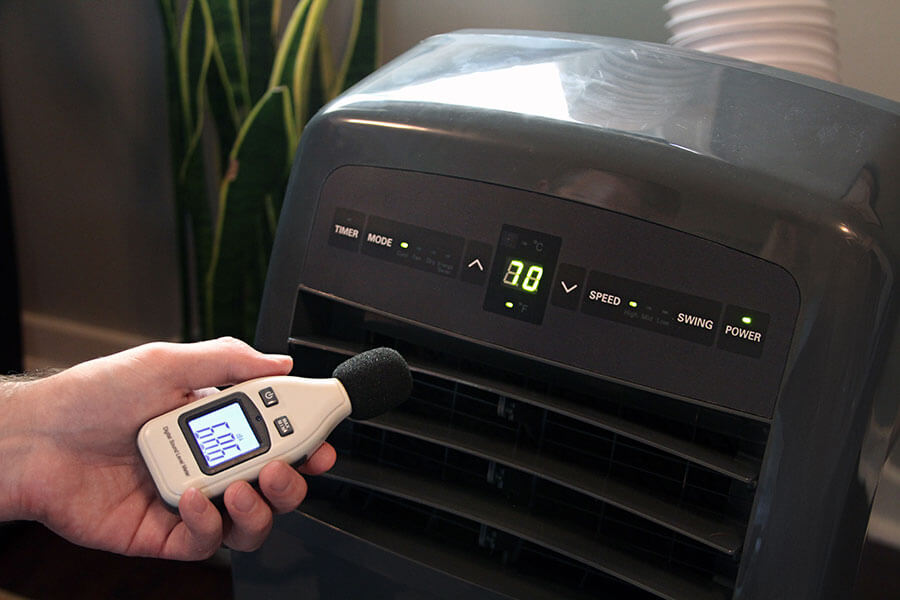
After all our cooling tests, we know these units can be loud. While you’re not going to get complaints from the neighbors, the worst offenders might disrupt your sleep. If you buy an AC unit to keep you from sweating all night, it shouldn’t make you pay for that comfort by waking you up.
There are two stages of sound levels for these units: the ongoing noise and the sound of the compressor turning on or off. Unless you buy an expensive inverter-driven model like this premium-price LG with its variable-speed design, air conditioners rumble to life when the room hits a temperature higher than you set, making their loudest sounds for just a split second.
This means that you’ll most likely find yourself shaken awake when the unit activates or deactivates throughout the night. Not an ideal situation. Most of them aren’t so loud that they would always wake you, but if they jar you in the wrong sleep stage, there’s a good chance you’ll be woken up.
For this reason, we measured both the ongoing average noise levels of each unit as well as the maximum level.
The 14,000 BTU Whynter, while the most powerful unit, was also the most brutally loud. That’s an instant nix if you’re considering it as a bedroom option.
On the other side of the sound spectrum, LG’s 2018 design has proven the quietest overall. You’re not going to mistake this machine for a room fan, but the sound of the compressor starting and stopping is muffled enough that you might miss it.
The smaller 12,000 BTU Whynter is a bit louder than the LG in normal operation, but the starting/stopping sound was less of an overall change in sound level. It’s a 1 dB difference either way, which is so small that it’s difficult to compare them without measuring equipment.
Sleep modes and remotes
Another irritating feature of many units is that you can’t turn off their LED lights. You’d think the product designers would have thought through the option to shut off the lights for people who prefer blacked out rooms (studies show it helps your sleep), but most didn’t.
LG is the standout here, with a mode activated by the remote control (or if you hold down the “timer” button on the top of the base unit) that will actually turn off the light. Frigidaire made an effort with a sleep mode that starts up the loud compressor less often, but the main light only dims very slightly, and the mode LEDs are still bright.
Dehumidifier modes
If you suffer through long, muggy summers, you may find the humidity-removal of these units valuable. Because we don’t live in an overly humid area, we weren’t able to test the maximum capacity of each, but the reported pints-per-hour ratings are excellent, with LG models condensing over 5 pints per hour compared to the typical 3 from popular dehumidifiers.
Note that all of these units are designed to operate in “dry” or “dehumidify” modes with the exhaust hose disconnected. Dry, warm air will circulate inside your room instead of cool air, and water will quickly fill the reservoir if you don’t attach a drain hose.
Important features to consider
If you’re sure you want to use this type of air conditioner, you may want to consider the following features.
Portability: Weight is the major concern when you’re lifting these up and down stairs, but also consider how tall the unit is if you’ll ever need to squeeze it into the front seat of a car to move it to the cottage or a friend’s house. (We’ve made all the 12,000 BTU models fit, but most just barely.)
BTU capacity: This is a measurement of how much heat the air conditioner can remove in an hour. Large rooms and hotter climates will need more BTUs See our investigation into BTU ratings below for details.
Double-hose vs. single-hose: This choice comes down to how hot your region gets. As temperatures rise above 90°F, the single-hose models stop being effective. Check out the details of our testing below.
Energy efficiency: The Department of Energy gives “Energy Star” awards to other air conditioner types if they can reach 12 BTUs per watt, but the new BTU tests have dramatically lowered the ratings of all portable units. You’ll probably see an “energy efficiency rating” on models tested before 2017, but newer advertising skips this listing.
A drain pump: If humidity is above 90 percent, you might fill up the water reservoir when running the AC and need to drain it frequently. If you don’t have a floor drain, some brands sell an alternate version with a pump so you don’t need to lift the unit to drain it. Even if you don’t spring for that feature, you can still use an external pump.
Window kit: all of these air conditioner units come with a three-piece expanding baffle that holds the hose in your window. You’ll need an extension for the window kit if your window opening is more than 36 inches.
How do portable air conditioners work?
If you want a more detailed rundown of the specifics, see our post on how portable air conditioners work here. But to sum it up: As room air passes over a metal tube, the a pressurized liquid is sprayed inside and changes to a gas, which allows it to soak up heat.
On the cold side of things, all air conditioners are very similar. The difference between a portable air conditioner and the window air conditioners we’ve reviewed is the location of the other half of the system, the hot compressor and “condenser” coil.
A portable has all that heated refrigerant sitting in your room with you. It can only get rid of heat by blowing a powerful fan over the condenser coil to blow heat out your window. Hence, the giant vent tubes and high noise level.
Window air conditioners and central air systems are more efficient because the parts that condense the refrigerant and fan away the captured heat stay outside your house.
You’re still able to enjoy cool air from a portable air conditioner, but the efficiency for cooling an entire room is poor. And when it’s an especially hot day, the story only gets worse.
Single vs. dual hose units

There are two ways to get enough air blowing over the condenser coil to remove all that heat: You can use the air from your room, or you can bring in air from outside, which is what the second hose in a “dual-hose” air conditioner does.
We asked Richard Ciresi, the owner of Aire Serv Heating & Air Conditioning in Louisville, to explain which cases make sense for a dual-hose system compared to the more popular single-hose designs.
“Generally speaking,” Richard says, “it depends on the temperature outside. A single-hose unit uses air that you have paid to condition and sends it outside. Warm air from the outdoors is then drawn into the space to replace the exhausted air.
“If it’s really warm outside, this gets expensive. If someone is using this device as a permanent solution, the [dual-hose air conditioner] will be an energy saver over the life of the unit.”
In our tests, we found that on a moderately hot day (up to about 87°F) the LG single-hose champion could beat the dual-hose Whynter at cooling a small room.
On hot summer evenings, when temperatures outside drop to the 80s but it’s still 85 inside after a scorching afternoon, the single-hose system also helps move all that hot air out and cools the room more quickly.
On a day when it climbed above 90°F outside, though, things changed. The dual-hose would still cool the room, while a single-hose unit couldn’t keep up. The single-hose model starts off with a fast-cooling drop since it’s drawing moderately cool air into the room from the rest of the house. That’s not ideal for efficiency, but if you only need one room to stay cool for half an hour it’s worth noting. After all the air in your house is replaced with outside air, a single-hose system can only add heat on a hot day.
Note that in either case, you’re still getting relatively cool air out of the front of your air conditioner compared to the rest of your room; the problem is with the average air temperature climbing.
Again, if heat is trapped inside the room (in kitchens, laundry rooms, or if you’ve got a room full of sweaty people) then dumping the hot air out a window can actually make the single-hose system more efficient. That’s not a typical situation for most people, though.
If you think you might benefit from a single-hose system, you can always remove the intake hose from a dual-hose machine to create a single-hose system. Adding an outside-intake hose for a single-hose system should be possible with a lot of duct tape or 3D printing, but that’s not realistic for most of us.
Many people insist that it only makes sense to buy an AC that will work as well as possible in the hottest conditions, and the dual-hose Whynter systems definitely fit that bill. Sadly, there aren’t many other manufacturers selling dual-hose units.
In Southern California (where we’re located), the difference between the dual-hose and single-hose systems is notable only a few weeks out of the year. For the rest of the summer, a cheaper and more refined single-hose system still gives much-needed relief.
How many BTUs do you need?

Since their main job is pumping heat energy out of your room, air conditioners are rated by their capacity for British thermal units (BTUs) of heat moved in an hour. (One BTU is the heat it takes to increase the temperature of one pound of water by one degree Fahrenheit.)
The air conditioner capacity rating is based on a standardized test designed for the appliance manufacturers by the American Society of Heating, Refrigerating and Air-Conditioning Engineers (ASHRAE). The test allows manufacturers to compare the size of air conditioner hardware in an ideal environment.
For a window unit or a central air system, you can use a calculator like the one in our window air conditioner review to see how much capacity you need to cool the volume of air in a room. These calculators are essential tools when buying most AC systems, so you can avoid spending money on a machine that’s bigger and draws more energy than is necessary for your home.
Calculating the heat load of your room also helps you avoid an over-sized system that makes your room damp instead of comfortable.
For a portable, though, that’s not the whole story.
DOE BTU ratings
In 2015 the Department of Energy proposed a new way to calculate BTU capacity of portable air conditioners that accounts for poor performance on very hot days, called an “adjusted cooling capacity.” Both single and dual-hose models were affected, but the single hose models got hit much harder.
Manufacturers pushed back, and amendments were made to the testing procedure. The adjustment is now weighted to reflect “seasonal” use: 80% of the performance rating is determined by tests with outdoor air at 83°F, and only 20 percent of the rating accounts for days at a mildly-hot 95°F.
The best 12,000 BTU portables, both single- and dual-hose, are down-rated to 7,500 under the new tests. Some consumer advocates would have liked to see the new testing demonstrate exactly how much worse a single-hose unit is on the very hottest days of the year, but the DOE was satisfied by data that shows 80 percent of the time most people run an AC when it’s about 83°F outside.
Products made since 2018 need to show the new DOE rating side-by-side with the old number, but remember that even the new down-rated number doesn’t tell the entire story.
Manufacturers insist on keeping exaggerated room-size recommendations, which we feel is downright disingenuous. In portables, calculating a BTU rating fit for your room size isn’t as simple as it is for window air conditioners. On the hottest days of the year, even a giant 14,000 BTU dual-hose portable (down-rated to 8,500 BTU) will struggle to keep up with the heat in a room where a more affordable 8,000 BTU window unit works very well.
Is bigger always better?
With a window air conditioner, buying a unit that’s too big will mean that it cools off the air before it can suck out the humidity, leaving your room dank. Portables tend not to cool quickly enough to have that problem, though. Models we tested also feature a “dry” mode that will redirect dry exhaust air into the room.
There are reasons to avoid extra-large portable air conditioners, though. In our testing, it became obvious that noise from bigger units in the 14,000 BTU range can be detrimental to sleep. The extra coolant and bigger coils make portability suffer, too: The Whynter 14,000 BTU model came in at a whopping 100 pounds compared to a typical 65.
Our recommended size bracket for most rooms is 12,000 BTUs (under the old ASHRAE raw-performance rating), but manage your expectations on hot days. If you don’t care about noise and portability, a bigger model will cool more effectively in large rooms. Just remember that you’re going to need to be working (or sleeping) close to these beasts to really stay cool.
Updates and long-term notes
This post was originally published in May of 2016. Over two summers we extensively compared the original LG 12,000 and a now-discontinued Haier 12,000 in two different rooms, and our favorable opinion of the LG was solidified.
We’ve bought new 12,000 BTU air conditioners from LG every time they release an update, including the 2017, 2018, and 2020 models. The 2015 model was our pick for three years, but theLG – LP1218GXR finally replaced it for best quiet cooling capacity. The 2020 update isn’t a real improvement, but it’s not as loud as the 2017 model was.
For the most recent update, we tested two top-selling models that are inexpensive enough to replace the Honeywell, quieter and only slightly less capable.
The bottom line
Since there are a bunch of factors to weigh, we can’t decide on an air conditioner for you, but we hope this information will be a helpful guide for your purchase.
If you live in a region that sees scorching heat waves on a regular basis, the dual-hose Whynter – ARC-122DS is definitely going to be the best choice. We’ll say it again, though: even great portable air conditioners aren’t very good at keeping up with extreme heat. The best window air conditioners keep the heat outside far better, and they’re also much quieter.
The SereneLife – SLACHT128 is sleek, lightweight, and easily portable. For this 2021 update, we’ve selected it as the best single-hose portable air conditioner. Although it’s not as effective as a dual-hose unit, it performed very well on an extreme-heat summer day.
If you’re between a rock and a hard place with a big sun-facing room and can’t install a window unit, Whynter’s dual-hose 14,000 BTU portable has more capacity and cools more efficiently than other portables. It’s gigantic and significantly louder than our top pick, but this is your best bet for rooms bigger than 200 square feet. It’s also a great choice if you need a bit of heat on chilly mornings.
And if you find yourself not wanting to shell out this much money for a clunky air conditioner, we also suggest checking out our review of the best fans for an affordable way to make the heat more bearable.
More Reviews
Masterbuilt - 20071117
Hamilton Beach - 41020
The Best Single-Cup Coffee Makers
Keurig - K-Elite


